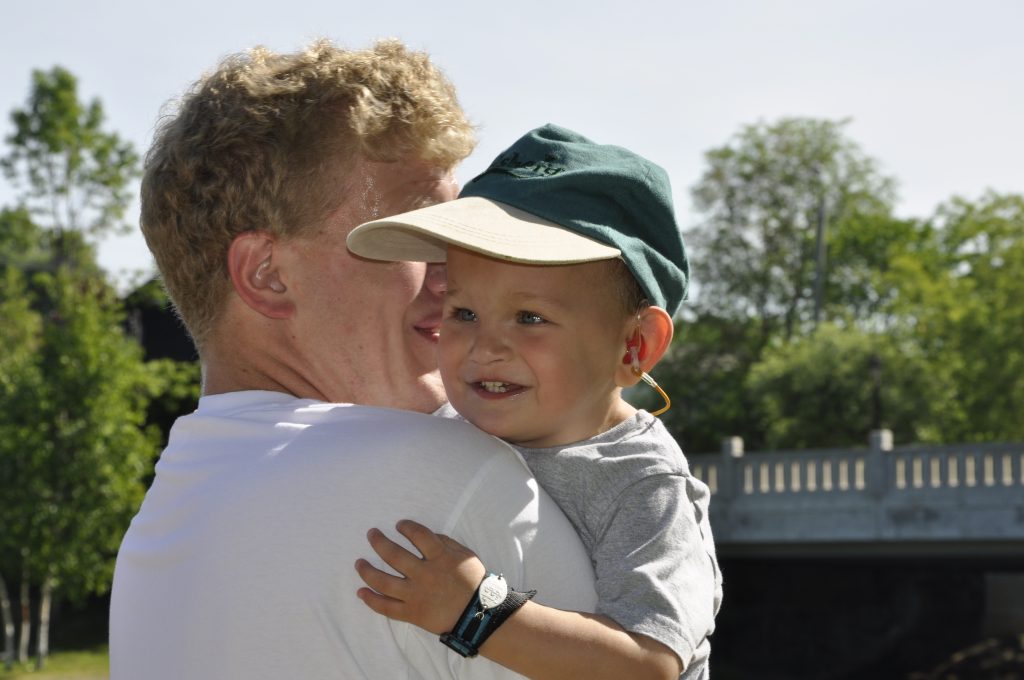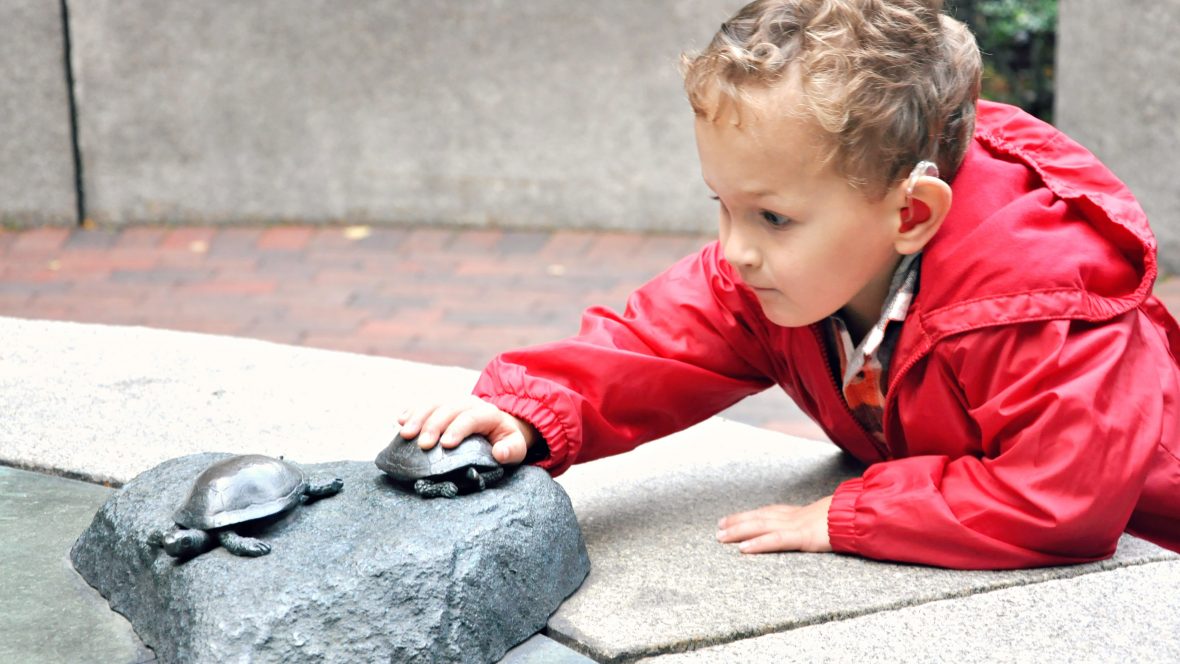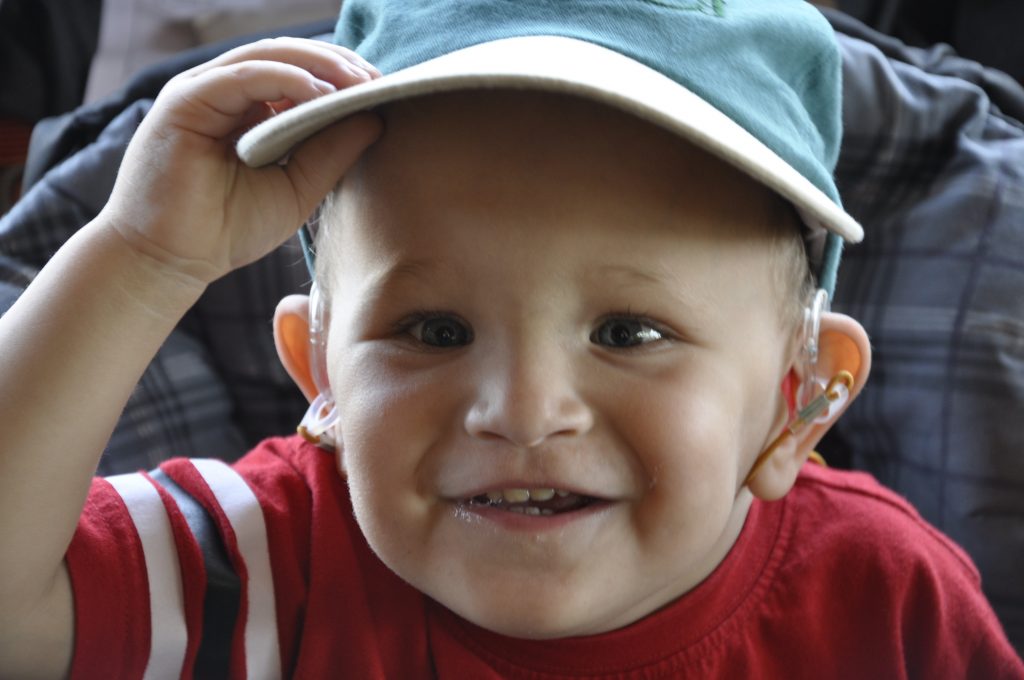Before his second birthday, my son said his first three syllable word thanks to his brand new hearing aids: Banana. Biologically, his corrected age made him a year and nine months old. He was so thrilled, he said, “banana,” several more times before piling the whole thing into his mouth.
Torran’s three month premature birth, and the multiple anoxic insults to his brain, caused auditory dys-synchonry with moderate to severe hearing loss. When Torran adapted to the hearing aids (which he first used in place of a soother) we thought our struggles with his hearing loss were over, however, my husband and I learned that putting hearing aids on our child was only a part of the solution. Modifying our behaviour, the way we talk to him, made all the difference to his ability to communicate with us. Here are our top 5 tips for talking to a child—or anyone—with hearing loss.
Stay in the Magic Circle
People with hearing assistive devices hear sound best within a four-foot radius, the “magic circle” of sound. For Torran, this meant being at the front during carpet time at school and staying within arm’s reach of the teacher during lessons that didn’t have additional amplification. When I have a conversation with him, I try to stay beside him, or at the very least, in the same room. Volume drops off significantly the farther away the person is from the source of the sound.
Face Your Talking Partner
Have you ever been at a wedding and the speech giver turns his head away from the microphone? It’s difficult to hear him, right? Sound drops off by 30% when you aren’t facing the person to whom you speak. Additionally, if your face is blocked by your hands or other objects (like a cell phone), a person with hearing loss may have a harder time hearing you. This is a particular challenge for Torran who also has Autism, and looks away from people during most of his conversations.
Reduce Environmental Noise
People who don’t have hearing loss (or an aversion to auditory stimuli) don’t realize how much we clutter our environment with sounds. Hearing assistive devices amplify all environmental sounds, not just the spoken word. In a location with background music, lots of people talking, or even near a busy street, it is harder for someone with hearing aids to hear the person speaking to them. Hearing aids may also distort sounds. I didn’t realize this fact until I “tried on” Torran’s hearing aids, and had an awakening to the constant drone of noise that I don’t hear or tune out.
Pace Your Rate of Speech
Even if the person with hearing loss is able to speak quickly, be mindful of how fast you talk—particularly when asking questions. This is something of which both my husband and I are guilty, given our professional employment (nurse and air traffic controller). We constantly have to remind ourselves to use simple sentences, ask direct questions, and avoid sudden changes in topic. I often use Torran’s name to start my sentence, capturing his attention, then count in my head for up to ten seconds as I wait for a response. However, pacing your speech (with or without raising your voice a little) shouldn’t look like a comic sketch with over-exaggerated words and volume. Speaking that way may be insulting to someone with hearing loss, and just as difficult for them to interpret.
Technology Helps
I attended a session by the school board about hard of hearing students in school. Surprisingly, student presenters said they preferred to watch television programs with closed captioning because they’re better able to follow the dialogue—even if they can hear the program. At home, we use a Phonak ComPilot (wireless Bluetooth streamer) near the TV speaker. The device transmits sound directly to Torran’s ears via the hearing aids, instead of cranking up the volume. I also use this device when we’re out in public places like festivals or theme parks, or even walking to school in the winter when layers of woollies cover his head and ears. I have the microphone clipped to my lapel, or held to my mouth, and he wears the receiver around his neck. It’s remarkable and so helpful! Bluetooth compatible hearing aids also help people with hearing loss use phones and computers, and Torran’s school has used both a sound field and an FM system to help him hear his teachers inside the classroom.
Not sure if your baby is hitting her speech milestones? Check out this handy list from birth to 30 months of age and remember that hearing is a factor in speech development.
 After eight years, Torran no longer uses his hearing aids as chew toys; he recognizes that they are as essential to his daily function as wearing glasses is to me. Tweaking the way I talk to him no longer feels unnatural, in fact, it spills over to the rest of my daily activities. For example, I try to look up at people when I’m at triage, I make eye contact when I enter the room, and try not to talk as I’m leaving it. I look forward to integrating other great technologies into Torran’s future—like Bluetooth telephones and computers that provide the sound directly into his hearing aid with his own volume controls. At least that way, I won’t have to yell at him to turn down the volume on his music…
After eight years, Torran no longer uses his hearing aids as chew toys; he recognizes that they are as essential to his daily function as wearing glasses is to me. Tweaking the way I talk to him no longer feels unnatural, in fact, it spills over to the rest of my daily activities. For example, I try to look up at people when I’m at triage, I make eye contact when I enter the room, and try not to talk as I’m leaving it. I look forward to integrating other great technologies into Torran’s future—like Bluetooth telephones and computers that provide the sound directly into his hearing aid with his own volume controls. At least that way, I won’t have to yell at him to turn down the volume on his music…





[…] Over the years, his love for flight hasn’t changed, but now I have to yell to speak to him even when we’re on the ground. The constant exposure to the deafening sound of the engine took its toll and, at 60 years old, he was forced to admit he needed hearing aids. […]
[…] issues, but I didn’t initiate protests for barrier-free buildings. I had a vague idea about how to talk to someone with hearing aids, even though I worked in health […]